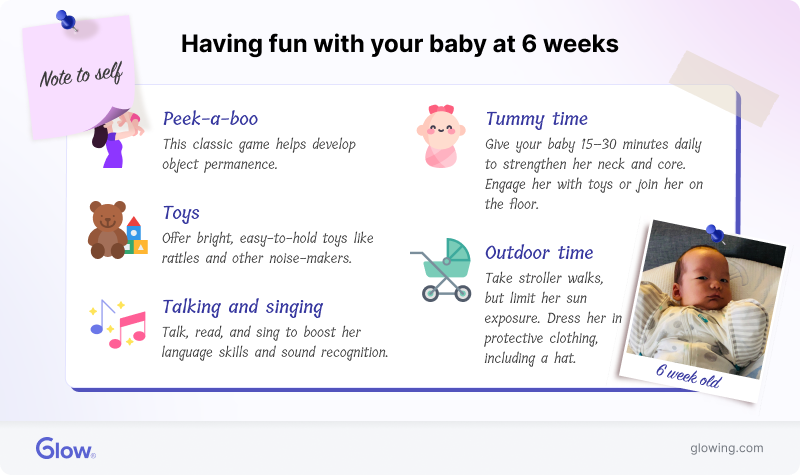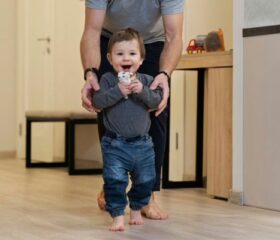Baby Month by Month
6-Week-Old Baby
You may see your baby’s “real” social smiles this week.

As your baby reaches 6 weeks old, you’ll start to notice some exciting changes. She’s becoming more interactive, and her personality is beginning to shine through.
She’s also getting bigger by the minute and is refining her skills by playing with you. Get ready for smiles, coos, and maybe even a few giggles. Let’s find out what you can expect with your 6-week-old baby.
Your baby at 6 weeks old
At six weeks, your baby isn’t just growing bigger; she’s also becoming more aware of the world around her. Here’s what you might notice this week:
- Social smiles: Get your camera ready! This week, you might see your baby’s first true “social smiles.” Unlike the gas-related smiles you may have seen before, these are a response to your interaction and a sign that she’s starting to connect with you. 1
- Increased awareness: Your baby’s vision is improving. She can now see high contrast objects about 12 inches away. You might notice her tracking your movements and getting more curious about her surroundings. 2
- Motor skills: While these are still developing, your baby might now be able to lift her head during tummy time. 3
- Vocalization: Someone’s getting talkative! You’ll hear your baby start to make more sounds around now. The 4 to 6-month mark is when babies start babbling for real. Listen for coos and gurgles as she explores her voice.
Your baby’s growth spurt
Around the 6-week mark, many babies go through a growth spurt. 4 As a result, you might find that your little one gets increasingly hungry and fussy.
Whether you’re breastfeeding or formula-feeding, your baby may want to eat more often. Breastfed babies often nurse more frequently for shorter periods, which is known as cluster feeding. This is just their way of telling mom to produce more milk. 5
If you’re formula-feeding, you might notice that your baby wants more than usual per session. Most of the time, it’s best to let your baby take the lead and give her more formula during this growth spurt.
As a general guideline, babies at this age should consume around 2.5 ounces of milk per pound of their body weight in a 24-hour period. 6
You can record how much and how often your baby eats in your journal or a baby tracker app. The best baby trackers also let you chart your baby’s feeding patterns so that you can see if she’s getting enough.
Your baby’s sleep patterns and challenges
Six-week-old babies still need a lot of sleep: 14–17 hours per day in total, with most of that happening at night. 7
That said, babies aren’t famous for being sound sleepers, and yours probably isn’t sleeping through the night just yet (which is typically defined as sleeping for an unbroken 5–6 hour stretch).
However, she may be working toward that by “consolidating” her sleep with longer periods of rest at a time, though she may only be awake for 1 to 3 hours at a time (also referred to as a wake window). These changes can be worrying, but they’re normal, so try not to panic if it seems like your baby is sleeping too much or too little.
Here’s what might be affecting your little one’s sleep this week:
- Growth spurt impact: Her sixth-week growth spurt may mean she’s more hungry at night, which consequently might make her more restless.
- Overstimulation: Everything’s brand new for your baby, and she might sometimes just be too excited to settle down and sleep.
- Being overtired: You might have heard of this somewhat paradoxical-seeming phenomenon. When babies get too tired, it stimulates a stress response in their bodies, which—frustratingly—can make it even harder for them to get to sleep.
- Colic: If your baby has “colic,” a very common condition with unclear causes that’s characterized by constant crying, you might have to say goodbye to peace and quiet for now. As frustrating as a colicky baby can be, be patient. Her colic will likely go away by itself by the time she’s 3 months old. 8
Should your baby be sleeping by herself yet?
Many babies prefer to be held when going to sleep, so you may struggle to get your little one to fall asleep on her own. There’s no such thing as “spoiling” a baby this young, but try gradually transitioning her to her own space, even if it means making several attempts over time.
Your baby’s cues
Babies at this age often begin practicing new facial expressions and sounds to let you know what they need. For example, a scrunched face and grunting could mean that your baby is gassy. A fussy cry could mean she’s hungry.
No two babies are the same (not even identical twins), so pay attention to your baby’s unique cues so you can better understand her.
Caring for your baby’s health
The hard truth is that babies are a lot of work, and yours is probably already having a lot of tiring (and messy) problems you have to deal with.
Most of the problems babies have at this age are normal and temporary, but you should still keep an eye on her and stay in regular contact with her pediatrician. Here are a few things to be mindful of:
Spit-up
Many babies spit up after feeding, and in most cases, it’s normal. As long as your baby is gaining weight and seems comfortable, there’s nothing to worry about.
However, if you find she’s losing weight or seems distressed, contact your baby’s pediatrician. 9
Most babies stop spitting up when they’re 6–7 months old, so you’ll still need to contend with those milky eruptions for a while. If your baby keeps frequently spitting up past that point, again, tell your pediatrician.
Epstein pearls
Many babies are born with small cysts filled with keratin (a protein found in skin, nails, and hair) on their gums or the roof of their mouth. These are known as Epstein pearls, and they’re usually harmless.
If your baby still has hers, don’t worry; they’ll probably clear by themselves without treatment in the next few weeks. Just keep an eye on them and let your doctor know if they haven’t disappeared after 3 months or if your baby has trouble feeding.
Soft spots (fontanelles)
Your baby has two soft spots on her head called fontanelles, and the smaller one (the posterior fontanelle) often closes between 6 and 8 weeks.
While her soft spots are more durable than you might think, try to watch out for bumps to her head. The thick membrane between her brain and skin (where her fontanelles are located) isn’t as strong as bone, so she’s more prone to injuries.
Monitor your baby for signs of choking
Keep a close eye on your baby when she’s feeding. If you notice her starting to choke, call 911 straight away and keep them on speakerphone while you attend to your baby.
Sneezing and a stuffy nose
Finding yourself saying “bless you” more often? If your baby is sneezing all the time, try not to worry. It’s probably just her way of clearing her airways and usually doesn’t suggest anything serious.
It’s also common for newborns to get congested, either due to environmental irritants or respiratory viruses.
With all that said, if you do find she’s overly congested, lethargic, or has a fever, contact your doctor. Never give your baby over-the-counter medications without their approval.
Bleeding belly button
By now, your baby should have lost her umbilical stump, and you might see a scab there.
If you see a little blood in her belly button, it’s probably just from one of her scabs getting scratched off.
However, if her belly button continues to bleed and she has a fever (even a low-level one), contact your doctor immediately. 10
Diaper rash
You might see a diaper rash when you change your baby. This can be uncomfortable for your newborn, but it’s also very common.
Diaper rash is usually caused by too much moisture, friction, and irritation in the area where your baby’s diapers sit. You can prevent it by:
- Changing diapers more frequently: Try to change your baby’s diapers at least once every 2 hours to prevent moisture from sticking around for too long. (And let’s face it, would you want to be stuck in a dirty diaper all day?) 11
- Applying a barrier cream: After changing your baby, put an ointment or a cream with zinc oxide or petroleum jelly on her to repel moisture and create a natural barrier between her skin and the diaper. 12
- Trying different diapers: Try switching to a different brand of diapers (you could even try cloth diapers). Everyone’s skin is different, your baby included, so hers might just be extra sensitive if she’s getting more rashes than you think is normal.
Cradle cap
Scaly patches may make a surprise appearance on your baby’s scalp. While it’s alarming to see, this condition, known as cradle cap, is usually harmless and shouldn’t interfere with your baby’s ability to sleep and eat.
It normally goes away on its own with some extra attention (gentle shampoo, frequent hair washes, scalp moisturizers, and soft brushing).
See your doctor if you have any concerns about your baby’s skin, whether or not you think it’s cradle cap.
Baby acne
Baby acne, also known as neonatal acne or neonatal cephalic pustulosis, normally appears within the first six weeks of life. It’s usually harmless, so while it may be alarming, try not to panic if you see breakouts on your baby’s face, back, scalp, neck, or chest.
It normally doesn’t require treatment and should resolve on its own when you’re baby’s 4 months old to 6 months old. However, if it causes your baby discomfort, don’t hesitate to reach out to your doctor.

Having fun with your baby
There’s more to caring for your little one than just feeding her, putting her to sleep, and changing her diapers. You should also play with her and keep her stimulated.
Here’s how you can have fun with your baby while ensuring she keeps progressing well:
- Tummy time: At six weeks old, your baby should be getting at least 15–30 minutes of tummy time daily, which helps strengthen her neck and core. 13 If your baby isn’t a fan, try making it more interesting by getting down on the floor with her or bringing some of her favorite toys into the mix.
- Outdoor time: It’s a big world out there, so let your baby see it! Take her for walks in the baby stroller. Be sure to limit direct sun exposure and dress her in protective clothing, including a hat.
- Peek-a-boo: It’s a cliché for a reason—babies love peek-a-boo. This simple game is not only fun to play with your little one, but it helps her develop her sense of object permanence.
- Toys: Remember how much you loved toys when you were a kid? Well, let your baby enjoy them, too. Introduce brightly colored, age-appropriate toys that she can easily hold. Rattles and any toys that make noise are a great choice.
- Talking and singing: Talk, read, and sing to your baby. This will help her learn language and develop an understanding of different sounds and colors.
How to look after yourself with a 6-week-old baby
Taking care of a baby is hard work, and you need to look after yourself, too. Here’s everything you should know and do when it comes to your own self-care.
Attend your postpartum check-up
This week, you’ll have your six-week postpartum checkup. Your doctor will use this to check on your physical, mental, and emotional recovery.
Specifically, this visit involves: 14
- Checking how your body is recovering after labor
- Monitoring your blood pressure (especially if you had high blood pressure during pregnancy)
- Discussing your mental health (talk to your doctor if you suspect you have postpartum depression or postpartum rage)
If you had an episiotomy or a Caesarean section, your doctor may also check if your stitches have healed.
Ask about diastasis recti
One common condition after pregnancy is diastasis recti, where your left and right abdominal muscles separate. You can identify it if you have a noticeable bulge in your mid-section that doesn’t go away even after exercise or losing weight.
If you think you might have this, rest assured that it usually passes by itself. Still, let your doctor know. They can advise you on how to prevent or treat it and give you recommendations for appropriate diastasis recti exercises. 15
Listen to your body
You’ve been through a lot. It’s OK to take it slow when you get back into exercise and other daily activities.
If you’re ready to be sexually active again, ease into it and keep communicating openly with your partner. If you have any pain or discomfort, stop right away. Your healing needs to come first; sex will still be available when you’re really and truly ready.
Don’t hesitate to ask your family or friends to help you out with household tasks and other errands so you can get some well-deserved rest. It’s also more than OK to put your baby down in her crib to take a short break once in a while.
Plan your meals
With your schedule almost completely revolving around your baby, it can be hard to eat well. Junk food is often the quickest and easiest option, but still, do your best to eat healthy. If you’re strapped for time, try to prepare meals and snacks in advance when you get some free time.
How to get ready to go back to work
The time has flown by, and you might already be gearing up to go back to work.
Whether you’re dreading leaving your little bundle of joy behind or looking forward to a much-needed reprieve from dirty diapers, here’s how you can make your transition back go much more smoothly:
- Introduce a bottle: If you’re breastfeeding, start introducing a bottle to your baby once a day so she can get used to it. The best baby bottles have anti-colic designs to stop babies from swallowing too much air and getting gassy.
- Start pumping: Once you’ve settled on a breast pump, begin pumping breast milk to stockpile for when you return to work. Store your breast milk in the freezer with dates clearly marked. You can keep breast milk in a freezer for up to 12 months, though it’s better for your baby to drink it within 6 months. 16
Try pumping in between nursing sessions or first thing in the morning when you have more milk.
Final thoughts
As you enter your baby’s 6th week, you’ll both get to know each other better, especially as she starts interacting more with the world around her. While there may still be challenges, like increased fussiness and disrupted sleep, these are temporary.
Be patient, get some rest when you need it (and when you can), and, above all, have fun with your beautiful baby! Before you know it, she’ll be crawling, babbling, and eating solid foods.
Article Sources
- Texas Health Resources. "When Do Babies First Smile?" Retrieved July 16, 2025.
- Nationwide Children’s Hospital. "Infant Vision Birth to One Year" Retrieved July 16, 2025.
- Lumen Learning. "Motor and Sensory Development" Retrieved July 16, 2025.
- Missouri Department of Health and Senior Services. "Foods To Grow On" Retrieved July 16, 2025.
- WIC Breastfeeding Support. "Cluster Feeding and Growth Spurts" Retrieved July 16, 2025.
- Breastfeeding Center of Ann Arbor. "Bottle Feeding Help" Retrieved July 16, 2025.
- Nemours KidsHealth. "Sleep and Your Newborn" Retrieved July 16, 2025.
- Johns Hopkins Medicine. "Colic" Retrieved July 16, 2025.
- MyHealth.Alberta.ca. "Spitting Up" Retrieved July 16, 2025.
- Pregnancy, Birth and Baby. "Umbilical cord care" Retrieved July 16, 2025.
- International Journal of Women's Dermatology. "Art of prevention: The importance of proper diapering practices" Retrieved July 16, 2025.
- University of Michigan Health-Sparrow. "Diaper rash" Retrieved July 16, 2025.
- Safe to Sleep. "Tummy Time for a Healthy Baby" Retrieved July 16, 2025.
- American College of Obstetricians and Gynecologists. "What to Expect at a Postpartum Checkup—And Why the Visit Matters" Retrieved July 16, 2025.
- MedlinePlus. "Diastasis recti" Retrieved July 16, 2025.
- U.S. Centers for Disease Control and Prevention. "Breast Milk Storage and Preparation" Retrieved July 16, 2025.






